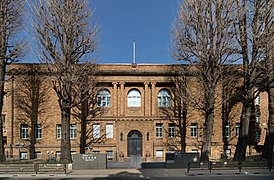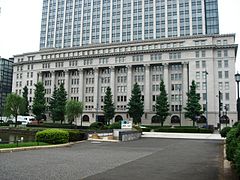Okada Shin'ichirō
Okada Shin'ichirō ( Japanese 岡田 信 一郎 ; born November 20, 1883 in Tokyo ; died April 4, 1932 ) was a Japanese architect of the Meiji , Taishō and early Shōwa periods .
life and work
After Okada Shin'ichirō had graduated from the Department of Architecture at the University of Tokyo in 1906 , he took on a teaching position at the "Tōkyō Bijutsu Gakkō" ( 東京 美術 学校 ), the forerunner of the Tōkyō Geijutsu Daigaku , the following year, but began his at the same time Work as an architect.
Okada had made himself thoroughly familiar with Western architecture, but strictly rejected unreflective imitation. He was also an opponent of always adapting the latest development. The best example of his practiced serenity is the Meiji Life Insurance ( 明治 生命 館 Meiji Seimeikan ) building from 1934. The Kabuki Theater in Tokyo , built in 1925, and the Toraya Candy Store 1930, also in Tokyo, are examples of this Implementation of traditional Japanese architecture in concrete buildings. These buildings were highly recognized at that time and led to similar buildings by other architects. Other well-known buildings are the Takashimaya Department Store in Osaka (1922) and the Tokyo Prefecture Art Museum in 1927.
photos
Remarks
- ↑ The Nikolai Church, or correctly "Church of the Resurrection", is a Russian Orthodox church in Tōkyō. It was rebuilt after the Great Kanto Earthquake .
- ↑ As with other buildings from the time, the only facade of the old building has been retained and a modern high-rise behind it.
literature
- Tazawa, Yutaka: Shin'ichirō Okada . In: Biographical Dictionary of Japanese Art. Kodansha International, 1981. ISBN 0-87011-488-3 .
- Japan Architect (Ed.): Nogi Center. In: A Guide to Japanese Architecture. Shinkenchiku-sha, 1975.
Web links
| personal data | |
|---|---|
| SURNAME | Okada, Shin'ichirō |
| ALTERNATIVE NAMES | 岡田 信 一郎 (Japanese) |
| BRIEF DESCRIPTION | Japanese architect |
| DATE OF BIRTH | November 20, 1883 |
| PLACE OF BIRTH | Tokyo |
| DATE OF DEATH | April 4, 1932 |







